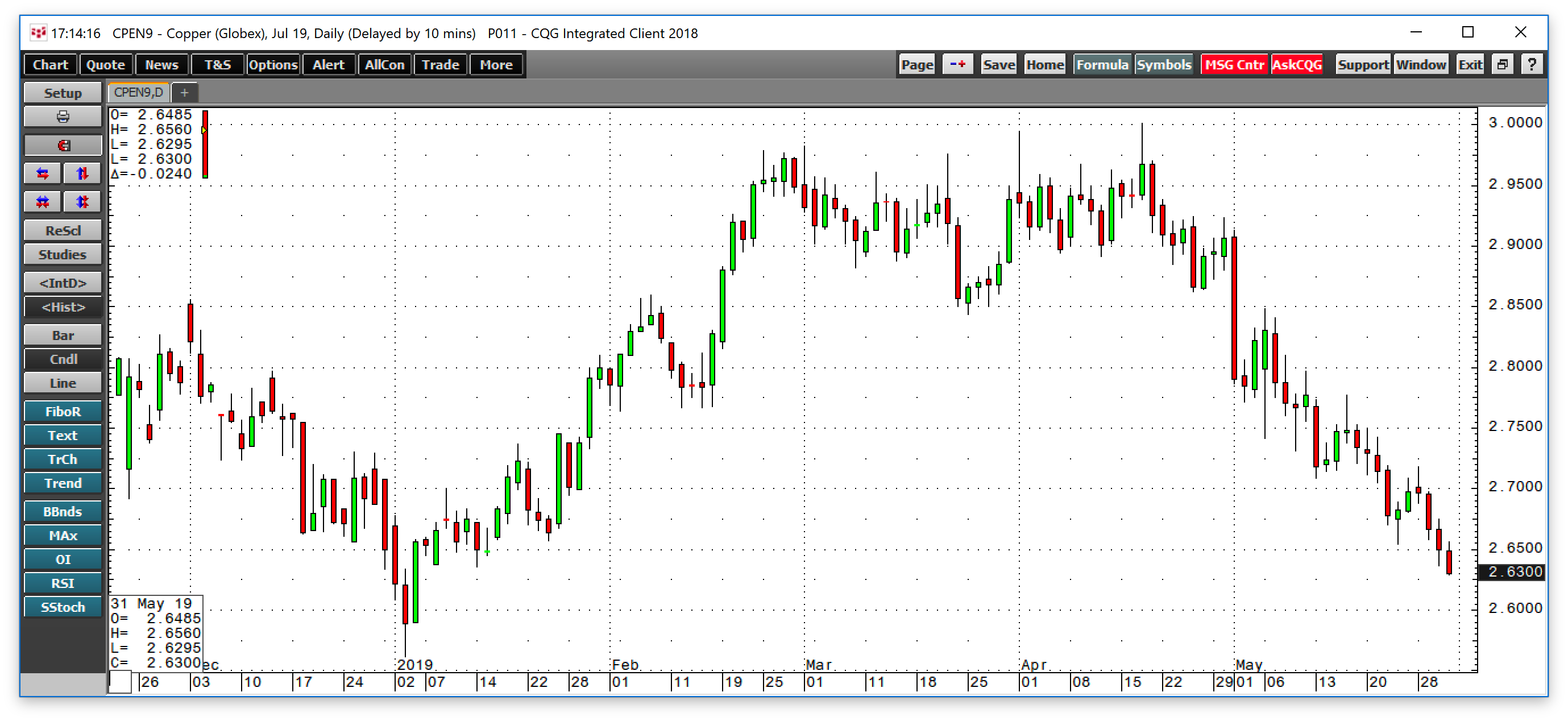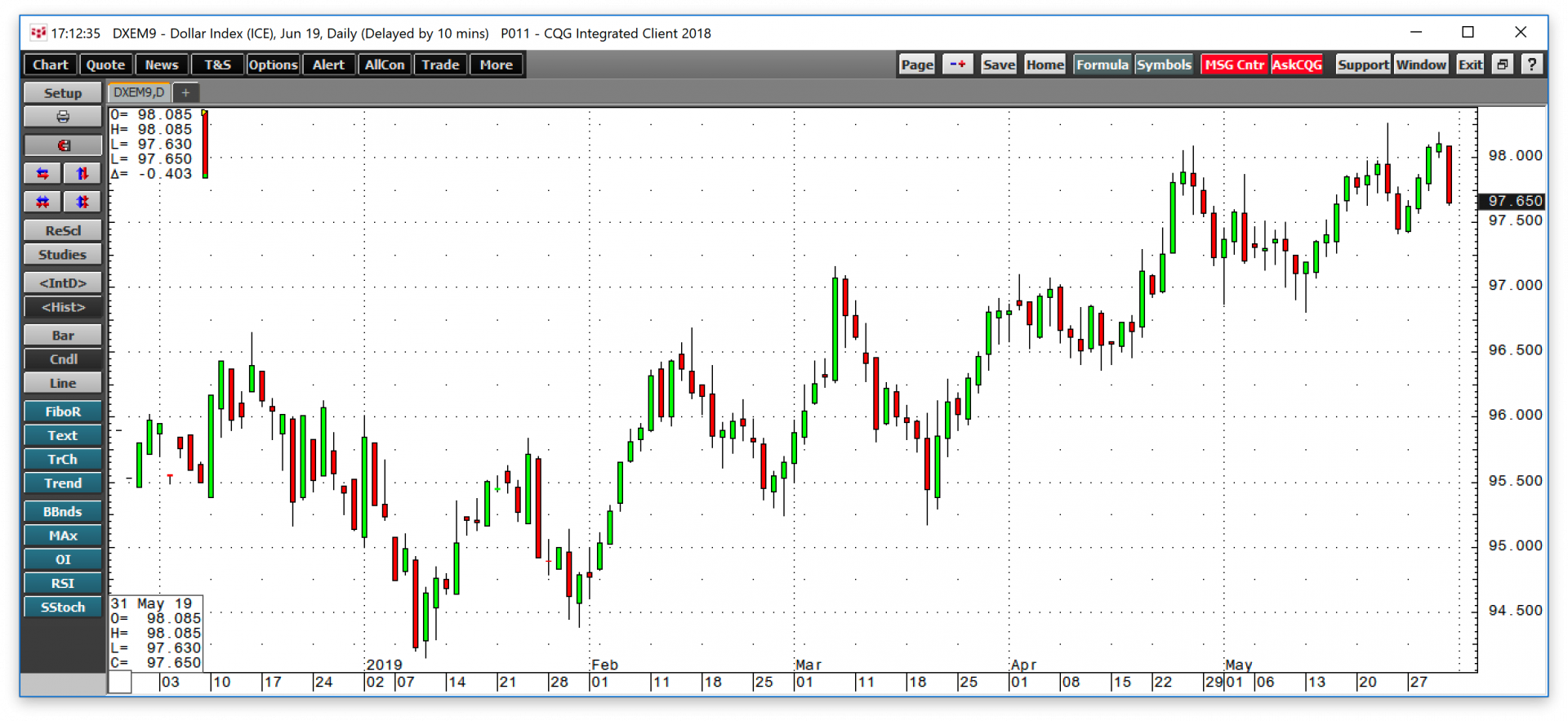Commodities are global assets. Raw material production is a local affair as minerals, ores, metals, and energy output comes from parts of the world where the earth's crust is rich in resources. When it comes to agricultural commodities, soil, the weather, climate, and water availability determine where crops can flourish. Therefore, supplies are concentrated.
On the other side of the fundamental equation, demand is ubiquitous as people all over the world require food, shelter, and energy to power their daily lives. We are all consumers of raw materials on both an individual and corporate level.
Commodities prices experienced increase price volatility during May, and that is likely to continue in June as the market will be watching at least three significant events that could determine the path of least resistance of raw materials prices and markets across all asset classes.
Commodities prices slip on a strong dollar, an escalation in the trade dispute, and fears over the global economy
The inverse relationship between the dollar and commodities prices weighed on the prices of industrial raw materials in May.
As the US dollar index futures contract daily chart shows, the US currency moved from 97.225 at the end of April to a new high at 98.26 and was around the 97.666 level at the end of May. On the final day of the month, President Trump’s announcement that he will slap tariffs on Mexico over the immigration issue caused the dollar to fall.
 July copper futures closed April at just over the $2.90 level and fell to a low at $2.6295 in May. Copper closed at the end of May at $2.6400 per pound.
July copper futures closed April at just over the $2.90 level and fell to a low at $2.6295 in May. Copper closed at the end of May at $2.6400 per pound.
July crude oil futures closed April at $63.53 and fell to a low at $53.05 before settling at the end of May near the low at $53.50 per barrel.
July lumber futures declined from $343.70 on April 30 to $305.50 per 1,000 board feet on May 31 after reaching a low at $286.10. There are many other examples of industrial commodities that suffered losses in May on the back of the stronger dollar and escalation of the trade dispute between the US and China. The tariffs on Mexico added another dimension to the impact of trade on markets.
As the trade negotiations stalled and the US accused China of backtracking on issues where they thought a meeting of the minds was in place, on May 10 President Trump hiked tariffs from 10% to 25%. On May 13, the Chinese retaliated with protectionist measures aimed at US exports to the world’s most populous nation. The optimism surrounding the chances of a new framework for trade earlier this year turned to pessimism in May which stoked fears of a global recession. The wave of protectionism and escalation of tariffs weighs more on the Chinese than the US economy. A continuation of the economic slowdown in China could cause contagion around the globe which weighed on raw material prices, and markets across other asset classes. The fear and uncertainty cause bouts of safe-haven buying in US government bonds, gold, and the Japanese yen.
June could be a busy month as there are three events on the calendar that are likely to cause an increase in market volatility.
The June 11 WASDE report will provide fundamental guidance for agricultural commodities
The US is the world’s leading producer and exporter of soybeans and corn, and an exporter of wheat. The USDA released its May World Agricultural Supply and Demand Estimates report on May 10, the day that the US slapped the Chinese with new and higher tariffs. The May WASDE did not reflect the escalation in the trade dispute, nor did it focus on the floods and excessive moisture across the US that delayed planting. The prices of the three leading grains fell to lows on May 13 on a combination of a bearish WASDE report and the trade situation. However, prices recovered with corn and wheat leading the way on the upside. The price of soybeans, which have been in the direct crosshairs of the trade dispute, also recovered alongside gains in the corn and wheat futures markets.
On June 11, at noon EST, the USDA will release its June WASDE report which should give a more robust picture of the 2019 crop year as it moves into the growing season. The delayed planting, which is still going on, could cause problems for crops if the weather turned hot and dry across the fertile plains of the US. It will be Mother Nature that determines the path of least resistance for prices, but any news or developments on trade between the US and China and now Mexico, and perhaps other trading partners, could cause additional volatility in the agricultural futures markets in June.
The OPEC meeting on June 25-26 will determine production policy and could be a circus
Crude oil and oil products had a rough month in May. After rising to highs in April, the price of WTI futures fell below the $60 level on May 23, and Brent future moved under $70 per barrel. The correction in the oil market took prices to their lowest levels since January as they are approaching $50 for WTI and $60 per barrel for Brent.
While the cancelation of exemptions for the eight countries that purchase crude oil from Iran has increased tensions in the Middle East, crude oil fell on the back of a falling stock market, fears over global trade, and a stronger dollar. However, in a sign that the Middle East could be a significant factor over the coming weeks and months, the spread between Brent and WTI widened to the highest level in 2019 and since last October when the energy commodity was on the highs.
As the weekly chart shows, the premium for Brent crude oil in the July futures rose to $11.59 which is just over the May 2018 peak at $11.55 per barrel. Record US production of 12.3 million barrels per day and rising inventories over the recent weeks combined with the 1.2 million barrel per day output cut by OPEC has been one factor that caused the spread to widen. Moreover, with rhetoric flying back and forth between Iran and Washington DC, any hostilities in the region that cause supply disruptions or impact production, refining, or logistical routes in the Middle East would increase the potential for sudden price spikes to the upside. Attacks on several oil tankers near the Strait of Hormuz and a drone attack on a Saudi pipeline near Riyadh could be harbingers of future actions by Iran. The USS dispatched the USS Abraham Lincoln warship to the region to make sure that oil continues to flow through the Strait of Hormuz and to respond to any provocative actions by Iran against the US and its allies in the region. The US declared that all members of Iran’s Revolutionary Guard are terrorists, and the Iranians responded by saying that any US troops stationed in the Middle East are terrorists. The situation in the Middle East could cause lots of volatility in the oil markets, as well as other assets, over the coming weeks and months.
On June 25 and 26, the oil ministers of OPEC will gather for their biannual meeting in Vienna, Austria. It is unlikely that the cartel will come up with any policy decisions on the first day of the official session. On June 26, the Russians will join the meeting which will decide on if the cartel will continue the 1.2 million barrel per day production cut for the second half of the year. Saudi Arabia and Iran are members of the cartel as well as arch-enemies. Russia's presence and participation in output policy have kept the cartel together since 2016. The oil market could be volatile around the time of the meeting on speculation if the cartel will continue with the cuts through the end of this year or alter them because the price of crude oil is higher than at their last meeting despite the recent correction.
The G20 meeting features a meeting between Presidents Trump and Xi over trade
On June 28-29 in Osaka, Japan, the leaders of the United States and China will sit down to discuss the trade dispute, which is likely the most significant event in June for markets across all asset classes. If no progress settles some of the issues and leads to a resumption of talks and negotiations, we could see a further escalation that thrusts both sides into a prolonged trade and currency war. Markets across all asset classes will be waiting, watching, and hoping that the summit can turn the current pessimistic environment back into optimism. However, the rhetoric flying back and forth between Washington and Beijing has not provides much hope that the leaders will find a way to achieve an agreement.
Volatility with a capital V ahead for futures markets across all asset classes
We should expect lots of volatility in stocks, bonds, commodities, and even digital currencies, which have broken out on the upside, in June. Periods of fear and uncertainty are likely to lead to buying in gold, US bonds, and the Japanese yen as market participants head for shelters for capital.
Meanwhile, the crude oil market will be watching trade and the Middle East, which are currently pulling the energy commodity in opposite directions. Copper, base metal, and many industrial commodities prices have been a barometer for the trade dispute and should follow the news cycle over the coming weeks. In the agricultural sector, aside from trade, the weather in the US and other growing regions in the northern hemisphere will dictate the path of least resistance of prices.
In volatile markets, trading opportunities increase. Keep stops tight and take profits when they are on the table. Rising price variance is a paradise for nimble traders with their fingers on the changing pulse of markets.



